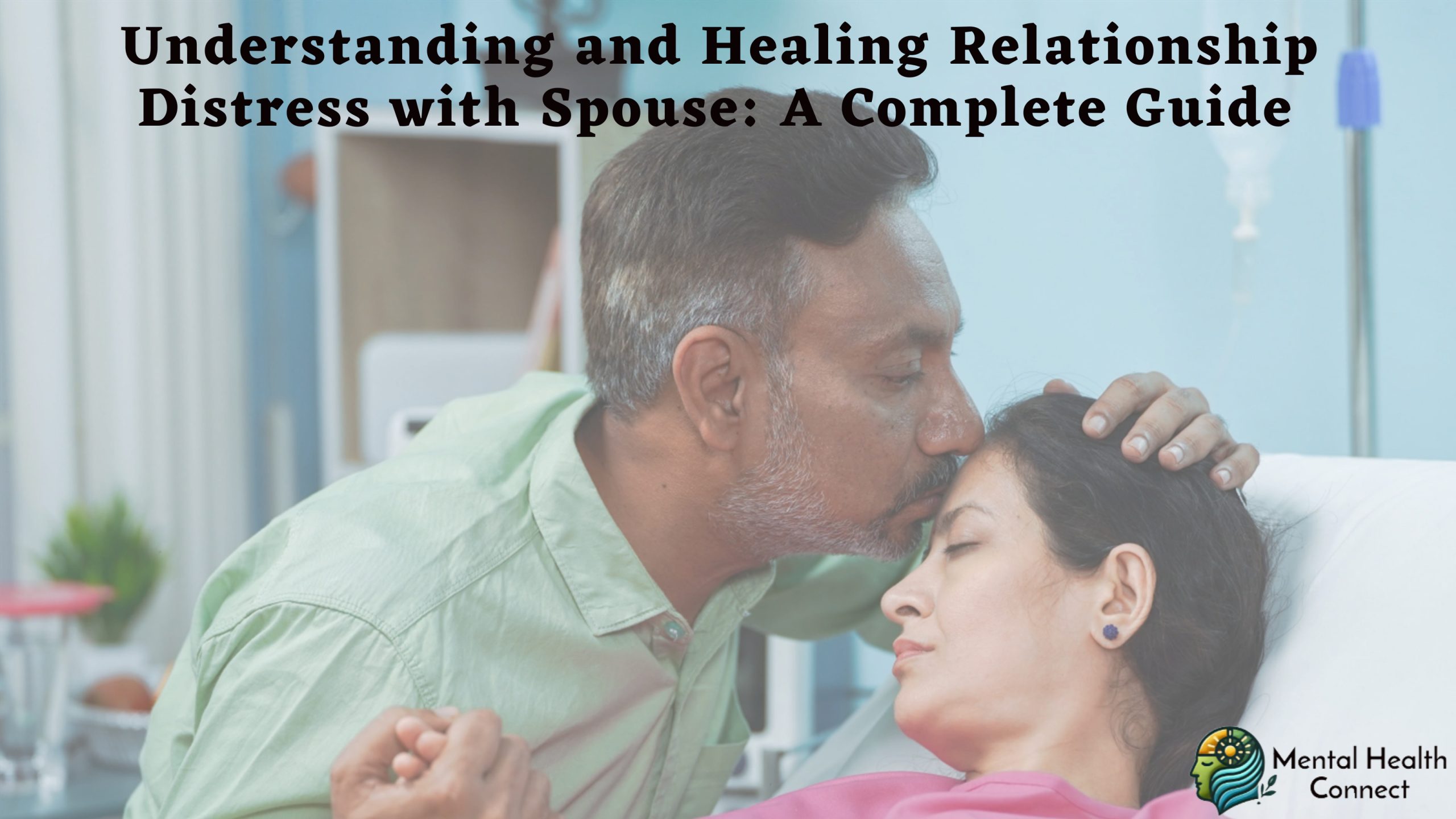Understanding and Healing Relationship Distress with Spouse: A Complete Guide

Marriage can be both deeply fulfilling and immensely challenging as couples navigate life’s complexities together. When communication breaks down, trust erodes, or emotional connection fades, relationship distress with spouse can develop, leaving partners feeling isolated and uncertain about their future together. This painful experience affects countless couples worldwide, creating ripples that impact mental health, family dynamics, and overall quality of life. Understanding the nature of relationship distress and developing effective strategies to address it is essential for rebuilding the foundation of a healthy, sustainable partnership.
What is Relationship Distress with Spouse?
Relationship distress with spouse refers to a persistent state of negative interaction patterns and diminished satisfaction within a marriage. It typically manifests through:
- Recurring conflicts that remain unresolved
- Communication breakdowns characterized by criticism, defensiveness, contempt, or stonewalling
- Emotional disconnection and decreased intimacy
- Experiencing profound isolation even while sharing your life with a spouse
- Loss of trust or security within the marriage
Signs and Symptoms
Signs of relationship distress may include:
- Avoiding time together or dreading interactions
- Feeling more like roommates than partners
- Experiencing anxiety or tension when anticipating spousal interactions
- Diminished physical and emotional intimacy
- Persistent feelings of being misunderstood or invalidated
Why Addressing Relationship Distress with Spouse is Important
Impact on Individual Well-being
- Increased risk of depression, anxiety, and stress-related health issues
- Compromised immune function and disrupted sleep patterns
- Reduced concentration and productivity in work and other areas of life
- Development of unhealthy coping mechanisms like substance use or emotional avoidance
Impact on Family System
- Creation of tense home environment affecting children’s emotional security
- Modeling of unhealthy relationship dynamics for the next generation
- Potential for parent-child relationships to become strained or triangulated
- Financial and logistical consequences if distress leads to separation
How to Address Relationship Distress with Spouse
Step 1: Recognize and Acknowledge the Problem
- Identify patterns rather than isolated incidents
- Consider how your relationship has changed over time
- Reflect on your contribution to negative cycles
- Approach your spouse with non-blaming observations
Step 2: Improve Communication Dynamics
- Practice active listening without interrupting
- Use “I” statements to express feelings without accusations
- Schedule regular check-ins away from distractions
- Learn to take effective time-outs before discussions escalate
Step 3: Rebuild Emotional Connection
- Create daily rituals of connection (greetings, goodbyes, brief check-ins)
- Express appreciation and gratitude consistently
- Share vulnerability about hopes, fears, and needs
- Gradually rebuild physical intimacy at a comfortable pace
Step 4: Seek Appropriate Support
- Consider couples therapy with evidence-based approaches
- Explore relationship workshops or education programs
- Utilize self-help resources like books or online courses
- Develop a support network that respects marriage boundaries
Best Practices for Managing Relationship Distress with Spouse
Focus on Friendship Foundation
Building or rebuilding friendship within marriage creates resilience against stress. This includes:
- Maintaining updated knowledge of spouse’s world (stresses, joys, interests)
- Creating opportunities for shared positive experiences
- Responding to bids for connection consistently
Cultivate a Culture of Appreciation
Counteract negativity bias by intentionally:
- Noticing and verbalizing partner’s positive qualities daily
- Expressing gratitude for specific actions and characteristics
- Creating rituals that celebrate relationship strengths and accomplishments
Develop Emotional Regulation Skills
Managing your own emotional responses helps de-escalate conflicts:
- Practice self-soothing techniques during difficult conversations
- Recognize personal triggers and develop strategies to stay present
- Take responsibility for communicating needs clearly and respectfully
Establish Shared Meaning
Creating shared purpose strengthens marital bonds through:
- Discussing and honoring each other’s values and dreams
- Developing family traditions and rituals
- Working together toward meaningful goals
Common Mistakes in Addressing Relationship Distress & How to Avoid Them
Waiting Too Long to Address Problems
Many couples delay seeking help until distress becomes severe. Instead:
- View relationship maintenance as ongoing rather than crisis management
- Address concerning patterns early before resentment builds
- Schedule regular relationship check-ins even when things seem stable
Focusing Exclusively on Problem-Solving
While resolving issues is important, emotional connection must come first:
- Prioritize understanding each other before solving problems
- Validate feelings even when disagreeing with perspectives
- Create safety for vulnerable sharing without immediate solutions
Expecting Quick Fixes
Relationship healing requires consistent effort over time:
- Set realistic expectations about the recovery timeline
- Celebrate small improvements rather than expecting perfection
- Commit to consistent small actions rather than dramatic gestures
Making Change Contingent on Partner’s Behavior
Focus first on changes within your control:
- Identify personal patterns that contribute to negative cycles
- Make changes regardless of whether your spouse reciprocates initially
- Recognize that unilateral positive changes often inspire reciprocation
Future Trends in Addressing Relationship Distress with Spouse
Technology-Enhanced Relationship Support
- Relationship health apps with customized intervention suggestions
- Virtual reality applications for practicing difficult conversations
- AI-assisted conflict pattern recognition and intervention recommendations
Integration of Mindfulness Approaches
- Growing emphasis on present-moment awareness in couple interactions
- Mindfulness-based relationship interventions becoming mainstream
- Increased focus on emotional regulation through contemplative practices
Preventative Relationship Education
- Shift toward proactive relationship skill development
- Integration of relationship education in healthcare settings
- Expanding accessibility of evidence-based relationship resources online
FAQs About Relationship Distress with Spouse
- How can I tell if my marriage is experiencing normal challenges versus serious relationship distress with spouse? Normal challenges tend to be situational and resolvable, while distress involves persistent negative patterns, declining satisfaction, and diminishing hope for improvement.
- Can a marriage recover from severe relationship distress? Yes, research shows many marriages successfully recover from significant distress with appropriate intervention and commitment from both partners.
- What if my spouse doesn’t acknowledge our relationship distress? Begin by changing your own approach to interactions, express concerns using non-blaming language, and consider writing a letter sharing your experience and desire for improvement.
- How long does it typically take to repair a distressed marriage? Recovery timelines vary widely based on distress severity, willingness to change, and consistency of effort. Significant improvements often begin within 3-6 months of consistent work.
- Should we stay together for the children despite ongoing relationship distress with spouse? Research suggests that high-conflict homes can negatively impact children’s development more than separated households where parents manage conflict effectively.
- What role does individual therapy play when experiencing relationship distress with spouse? Individual therapy can help address personal triggers, improve emotional regulation, heal past traumas affecting the relationship, and clarify your needs and boundaries.
- How do I know when to end a distressed marriage versus continuing to work on it? Consider factors like safety, presence of “The Four Horsemen” (criticism, contempt, defensiveness, stonewalling), willingness to change, and whether fundamental needs can ultimately be met within the relationship.
While painful, relationship distress with spouse often signals opportunities for transformative growth and deeper connection when approached with intention and care. By understanding the patterns creating distance, implementing evidence-based strategies to rebuild communication and emotional bonds, and possibly seeking professional guidance, couples can move from distress to renewed intimacy and satisfaction. Remember that healing relationship distress with spouse requires patience, consistency, and mutual commitment to creating a relationship that supports both partners’ wellbeing and growth. With dedicated effort and appropriate support, many marriages not only recover from distress but ultimately develop greater resilience and deeper connection than before.
Ready to transform your relationship? Take the first step toward healing your relationship distress with spouse today by having an honest conversation about one area where you’d like to improve your connection. Consider scheduling a consultation with a qualified marriage therapist, or commit to reading a research-based book on relationship repair together. Your marriage deserves this investment start the journey toward rebuilding your connection now.
-
 Beyond Words: The Emotional Medicine of a Simple HugOctober 27, 2025
Beyond Words: The Emotional Medicine of a Simple HugOctober 27, 2025 -
 Music’s Unique Therapeutic BenefitsOctober 23, 2025
Music’s Unique Therapeutic BenefitsOctober 23, 2025

Leave a Reply